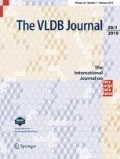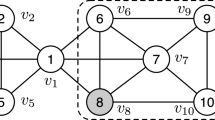Abstract
Community search is a problem of finding densely connected subgraphs that satisfy the query conditions in a network, which has attracted much attention in recent years. However, all the previous studies on community search do not consider the influence of a community. In this paper, we introduce a novel community model called k-influential community based on the concept of k-core to capture the influence of a community. Based on this community model, we propose a linear time online search algorithm to find the top-r k-influential communities in a network. To further speed up the influential community search algorithm, we devise a linear space data structure which supports efficient search of the top-r k-influential communities in optimal time. We also propose an efficient algorithm to maintain the data structure when the network is frequently updated. Additionally, we propose a novel I/O-efficient algorithm to find the top-r k-influential communities in a disk-resident graph under the assumption of \({{\mathcal {U}}}=O(n)\), where \({{\mathcal {U}}}\) and n denote the size of the main memory and the number of nodes, respectively. Finally, we conduct extensive experiments on six real-world massive networks, and the results demonstrate the efficiency and effectiveness of the proposed methods.


















Similar content being viewed by others
Notes
If the maximal k-core of G has more than one MCCs, the \(\mathsf {ICPS}\) is a forest, where each MCC generates a tree.
Suppose that each answer only contains the set of nodes in each community; otherwise, we simply compute the induced subgraph by the nodes in the answer.
References
Akiba, T., Iwata, Y., Yoshida, Y.: Linear-time enumeration of maximal k-edge-connected subgraphs in large networks by random contraction. In: CIKM (2013)
Batagelj, V., Zaversnik, M.: An O(m) algorithm for cores decomposition of networks. CoRR cs.DS/0310049 (2003)
Batagelj, V., Zaversnik, M.: Fast algorithms for determining (generalized) core groups in social networks. Adv. Data Anal. Classif. 5(2), 129–145 (2011)
Chang, L., Yu, J.X., Qin, L., Lin, X., Liu, C., Liang, W.: Efficiently computing k-edge connected components via graph decomposition. In: SIGMOD (2013)
Cheng, J., Ke, Y., Chu, S., Özsu, M.T.: Efficient core decomposition in massive networks. In: ICDE (2011)
Cheng, J., Ke, Y., Fu, A.W.C., Yu, J.X., Zhu, L.: Finding maximal cliques in massive networks. ACM Trans. Database Syst. 36(4), 21 (2011)
Cheng, J., Zhu, L., Ke, Y., Chu, S.: Fast algorithms for maximal clique enumeration with limited memory. In: KDD (2012)
Chiba, N., Nishizeki, T.: Arboricity and subgraph listing algorithms. SIAM J. Comput. 14(1), 210–223 (1985)
Cohen, J.: Trusses: Cohesive subgraphs for social network analysis. Technique report (2005)
Cormen, T.H., Leiserson, C.E., Rivest, R.L., Stein, C.: Introduction to Algorithms, 3rd edn. MIT Press, Cambridge (2009)
Cui, W., Xiao, Y., Wang, H., Lu, Y., Wang, W.: Online search of overlapping communities. In: SIGMOD (2013)
Cui, W., Xiao, Y., Wang, H., Wang, W.: Local search of communities in large graphs. In: SIGMOD (2014)
Fortunato, S.: Community detection in graphs. Phys. Rep. 486(3–5), 75–174 (2010)
Gregori, E., Lenzini, L., Orsini, C.: k-dense communities in the internet as-level topology graph. Comput. Netw. 57(1), 213–227 (2013)
Hu, X., Tao, Y., Chung, C.W.: Massive graph triangulation. In: SIGMOD (2013)
Huang, X., Cheng, H., Qin, L., Tian, W., Yu, J.X.: Querying k-truss community in large and dynamic graphs. SIGMOD (2014)
Jensen, T.R., Toft, B.: Graph Coloring Problems. Wiley, Hoboken (1995)
Li, R., Qin, L., Yu, J.X., Mao, R.: Influential community search in large networks. PVLDB 8(5), 509–520 (2015)
Li, R., Yu, J.X., Mao, R.: Efficient core maintenance in large dynamic graphs. IEEE Trans. Knowl. Data Eng. 26(10), 2453–2465 (2014)
Lin, M.C., Soulignac, F.J., Szwarcfiter, J.L.: Arboricity, h-index, and dynamic algorithms. Theor. Comput. Sci. 426, 75–90 (2012)
Moody, J., White, D.R.: Structural cohesion and embeddedness: a hierarchical concept of social groups. Am. Sociol. Rev. 68, 103–127 (2003)
Saito, K., Yamada, T.: Extracting communities from complex networks by the k-dense method. In: ICDM Workshops (2006)
Sariyüce, A.E., Gedik, B., Jacques-Silva, G., Wu, K.L., Çatalyürek, Ü.V.: Streaming algorithms for k-core decomposition. PVLDB 6(6), 433–444 (2013)
Seidman, S.B.: Network structure and minimum degree. Soc. Netw. 5(3), 269–287 (1983)
Sozio, M., Gionis, A.: The community-search problem and how to plan a successful cocktail party. In: KDD (2010)
Ugander, J., Backstrom, L., Marlow, C., Kleinberg, J.: Structural diversity in social contagion. PNAS (2011)
Wang, J., Cheng, J.: Truss decomposition in massive networks. PVLDB 5(9), 812–823 (2012)
Wang, N., Zhang, J., Tan, K.L., Tung, A.K.H.: On triangulation-based dense neighborhood graphs discovery. PVLDB 4(2), 58–68 (2010)
Wen, D., Qin, L., Zhang, Y., Lin, X., Yu, J.X.: I/o efficient core graph decomposition at web scale. In: ICDE (2016)
Xie, J., Kelley, S., Szymanski, B.K.: Overlapping community detection in networks: the state-of-the-art and comparative study. ACM Comput. Surv. 45(4), 43 (2013)
Zhang, Y., Parthasarathy, S.: Extracting, analyzing and visualizing triangle k-core motifs within networks. In: ICDE (2012)
Zhang, Z., Yu, J.X., Qin, L., Chang, L., Lin, X.: I/O efficient: computing sccs in massive graphs. In: SIGMOD (2013)
Zhang, Z., Yu, J.X., Qin, L., Shang, Z.: Divide & conquer: I/O efficient depth-first search. In: SIGMOD (2015)
Zhao, F., Tung, A.K.H.: Large scale cohesive subgraphs discovery for social network visual analysis. PVLDB 6(2), 85–96 (2012)
Zhou, R., Liu, C., Yu, J.X., Liang, W., Chen, B., Li, J.: Finding maximal k-edge-connected subgraphs from a large graph. In: EDBT (2012)
Acknowledgements
The work was supported in part by (i) NSFC Grants (61402292, U1301252), NSF-Shenzhen Grants (JCYJ20150324140036826, JCYJ20140418095735561), and Startup Grant of Shenzhen Kongque Program (827/000065); (ii) ARC DE140100999 and ARC DP160101513; (iii) Research Grants Council of the Hong Kong SAR, China, 14209314 and 14221716; (iv) China 863 Grants: 2015AA015305.
Author information
Authors and Affiliations
Corresponding authors
Rights and permissions
About this article
Cite this article
Li, RH., Qin, L., Yu, J.X. et al. Finding influential communities in massive networks. The VLDB Journal 26, 751–776 (2017). https://doi.org/10.1007/s00778-017-0467-4
Received:
Revised:
Accepted:
Published:
Issue Date:
DOI: https://doi.org/10.1007/s00778-017-0467-4




